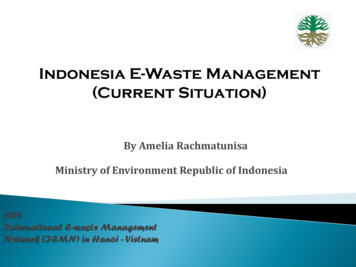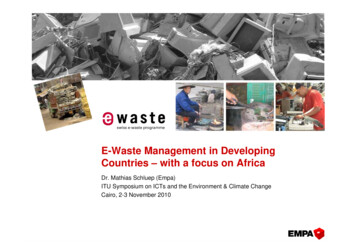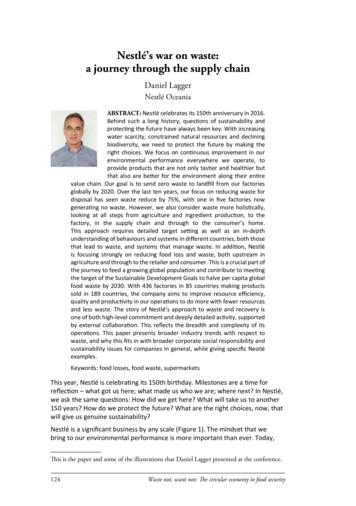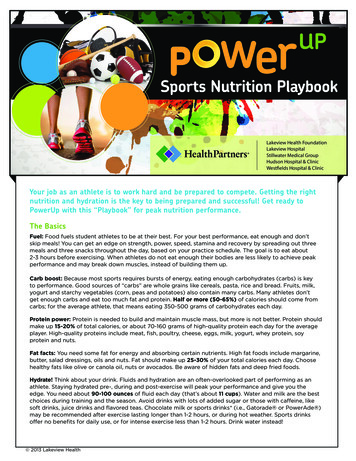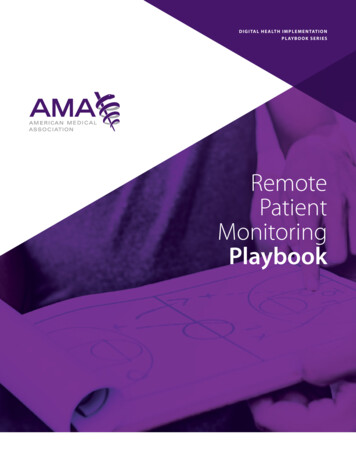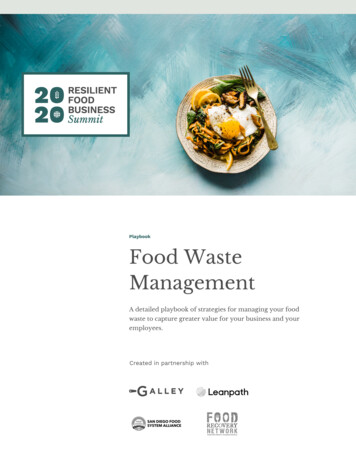
Transcription
PlaybookFood WasteManagementA detailed playbook of strategies for managing your foodwaste to capture greater value for your business and youremployees.Created in partnership with
We’ve collaborated with Resilient FoodBusiness Summit partners—Leanpath, SanDiego Food System Alliance, and the FoodRecovery Network—to compile the resourcesshared in the following pages.This playbook is one volume within a threepart series. The second volume will showcasecommunity and well-being focused resources,and the third volume will showcasetechnology solutions.As highlighted on the following pages, thereare multiple practices that your business canpursue to address food waste: Thinking from a systems level aboutyour kitchen and its relationship toother kitchens, supply chain partners,and the communityIntroductionFood Waste Managementas a Key Strategy forResilience appropriately so you don’t end uphaving your raw ingredients spoil underutilized ingredient by-productsheard about how food waste management is aadapt to the current world we find ourselvesliving in and increase its resilience as aGetting creative with your recipes andmenus to make the most ofAt the Resilient Food Business Summit, wekey strategy for a foodservice organization toPurchasing and storing foodand on-hand raw ingredients Managing food waste when you haveit so that when projections are off forbusiness.whatever reason, all of the team’s hardThis playbook summarizes some keymeals hasn’t gone to waste alongsidetakeaways from the Summit with respect tothe foodwork that went into preparing thefood waste management. The Summithighlighted how strong food wastemanagement programs can impact your triplebottom line—your profits, your people, andthe planet—ultimately standing up yourbusiness to be more resilient.Food Waste Management — Playbook2
Resource DetailsPractice: Thinking from a systems levelPartner contributor: LeanpathThe handout below shares a list of practices your operation can explore to think about food waste managementfrom a holistic systems perspective, considering the roles of multiple stakeholders.INCORPORATING FOOD WASTEREDUCTION INTO YOUR COVID-19OPERATING PLANSRestaurants and other foodservice businesses have been hitIDENTIFY INTERNALCHAMPIONSFind and elevate individuals (oftenon-site managers or social leaders)to prioritize and lead initiatives thatmake food waste unacceptable inyour restaurant’s culture.hard by COVID-19, and many still don’t know when they’ll be ableto reopen completely – or at all. Reducing food waste mattersnow more than ever, since it has a direct impact on businessinances and operations. Wasting less food can lower total foodcosts, but do your existing food waste reduction plans need tobe adjusted to relect this new environment?These guidelines can help you add food waste reduction proceduresinto your reopening and post-COVID operational plans.For additional information, please contact info@refed.com.MANAGEPRODUCTIONCAREFULLYDetermine your minimum merchandising levels, both in diversity andamount of product, as well as prioritizewhole-product and cross-utilization.Keeping hot foods hot and cold foodscold during storage, display anddelivery can reduce theamount of food discarded.LIMIT YOUR MENUSBe thoughtful about the size ofyour menu and the diversity ofoptions othe implications on forecasting,inventory, and waste management.Food Waste Management — PlaybookKNOW WHATYOU’RE WASTINGTrack what and how much you’rewasting, why it’s being wasted,and where it’s going. Pay attentionto how operational changes areimpacting waste.ENGAGE YOURTEAM IN A NEW“BUSINESS ASUSUAL”BUILD &STRENGTHENDONATIONPARTNERSHIPSIncorporating sustainablesolutions to food waste reductionrequires training and regularteam engagement.Learn about food recoveryorganizations in your communityand co-create recovery plans forboth normal operations andtimes of closure or crisis.COMMUNICATEWITH CONSUMERSHELP YOURCUSTOMERS REDUCEFOOD WASTEEngage a newly conscious andattentive audience about foodwaste reduction best practices.Look for opportunities to helpyour customers reduce food wastein their own homes with packagingthat facilitates storage andreduces spoilage.3
Resource DetailsPractice: Purchasing and storing food appropriatelyPartner contributor: Galley SolutionsStorage system design is the practice of maintaining an organized, methodical inventory system that makes it easyto take fast and accurate cycle counts and reduce over-purchasing by accounting for existing stock.Food Waste Management — Playbook4
Resource DetailsPractice: Purchasing and storing food appropriatelyPartner contributor: San Diego Food System AllianceIt’s easy to get excited about in-season produce, and potentially over-purchase when the price is right. Check outthe produce guidelines below for storage and utilization tips!Food Waste Management — Playbook5
Resource DetailsPractice: Purchasing and storing food appropriatelyPartner contributor: San Diego Food System AllianceIt’s easy to get excited about in-season produce, and potentially over-purchase when the price is right. Check outthe produce guidelines below for storage and utilization tips!Food Waste Management — Playbook6
Resource DetailsPractice: Purchasing and storing food appropriatelyPartner contributor: San Diego Food System AllianceIt’s easy to get excited about in-season produce, and potentially over-purchase when the price is right. Check outthe produce guidelines below for storage and utilization tips!Food Waste Management — Playbook7
Resource DetailsPractice: Purchasing and storing food appropriatelyPartner contributor: San Diego Food System AllianceIt’s easy to get excited about in-season produce, and potentially over-purchase when the price is right. Check outthe produce guidelines below for storage and utilization tips!Food Waste Management — Playbook8
Resource DetailsPractice: Getting creative with recipes and menusPartner contributor: Galley Solutions and Chefs using GalleyThis collection of recipes highlights how foodservice and food businesses are creatively innovating recipes andproducts to reduce food waste.Food Waste Management — Playbook9
Resource DetailsPractice: Getting creative with recipes and menusPartner contributor: Galley Solutions and Chefs using GalleyThis collection of recipes highlights how foodservice and food businesses are creatively innovating recipes andproducts to reduce food waste.Food Waste Management — Playbook10
Resource DetailsPractice: Managing surplus food when you have itPartner contributor: Food Recovery NetworkThere are a number of reasons that you might end up with an overproduction of perfectly good food. Programslike Food Recovery Verified can be implemented by a variety of foodservice organizations (not only universitydining), and demonstrate the business benefits of diverting that perfectly good food from landfill through foodrecovery efforts.Food Waste Management — Playbook11
This playbook has shared multiplepractices that your business canpursue to address food waste: Thinking from a systems level about your kitchen and itsrelationship to other kitchens, supply chain partners, andthe community Purchasing and storing food appropriately so you don’tend up having your raw ingredients spoil Getting creative with your recipes and menus to make themost of underutilized ingredient by-products and on-handraw ingredients Managing surplus food when you have it so that whenprojections are off for whatever reason, all of the team’shard work that went into preparing the meals hasn’t gone towaste alongside the foodStrong food waste management programs impact your triplebottom line—your profits, your people, and the planet—ultimatelystanding up your business to be more resilient.This playbook has been made possible by the Food Waste Preventionand Rescue Grant from CalRecycle, with funding from the CaliforniaClimate Investments.Food Waste Management — Playbook12
Reducing food waste matters now more than ever, since it has a direct impact on business inances and operations. Wasting less food can lower total food . This collection of recipes highlights how foodservice and food businesses are creatively innovating recipes

